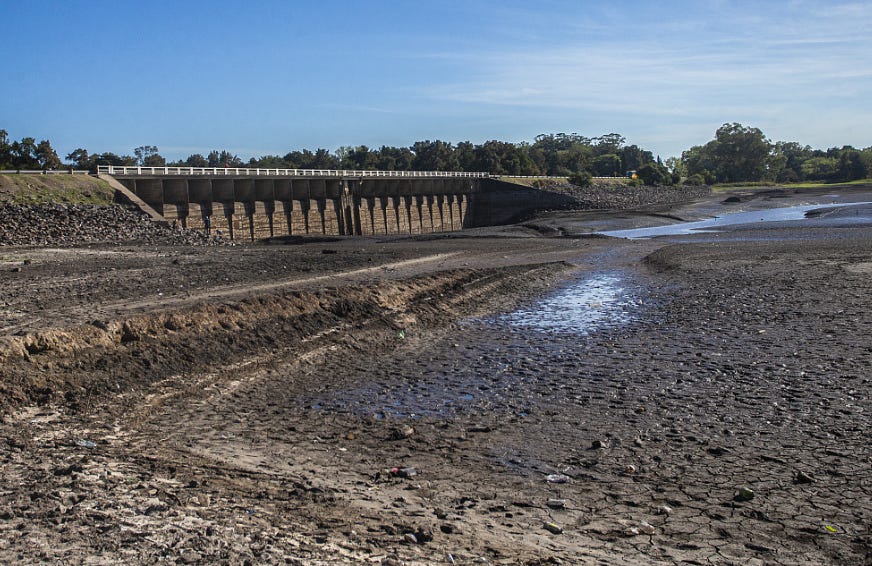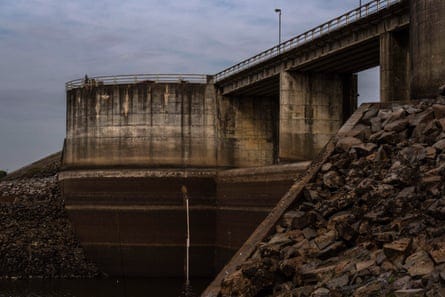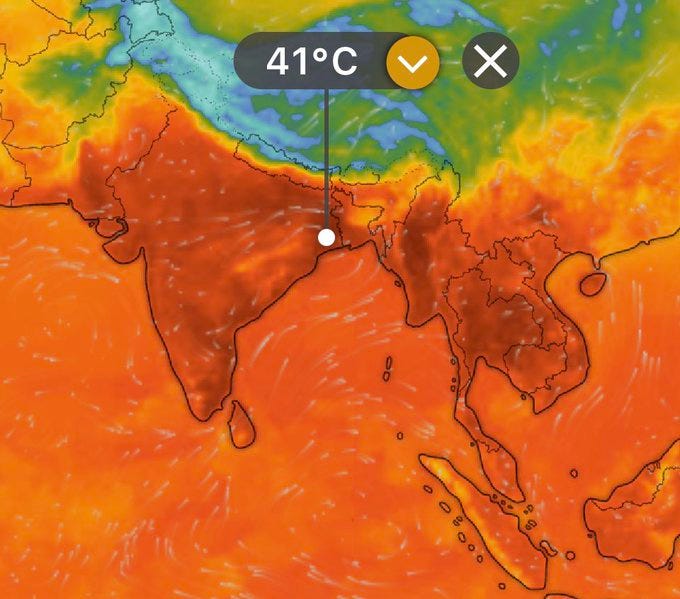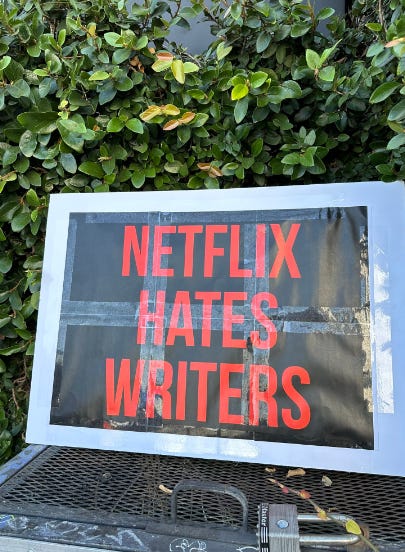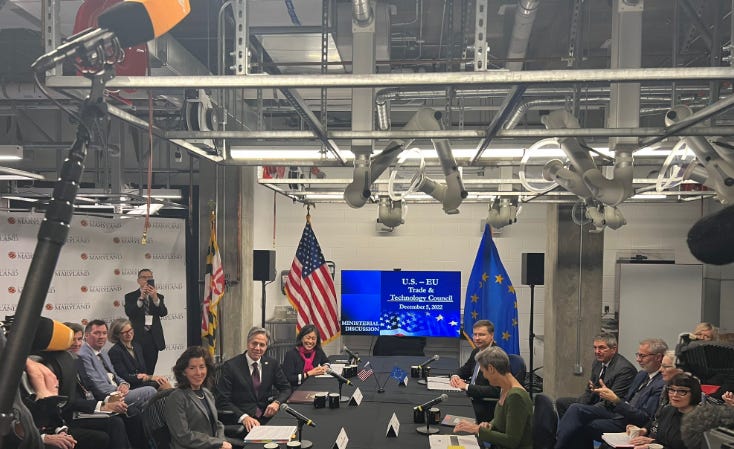Montevideo 8.44pm / DC 7.44pm / Silicon Valley 4.44pm
View of the dam at Canelon Grande reservoir as drought conditions continue on March 13, 2023 in Canelones, Uruguay. [Photo/VCG]
A plan to build a Google data centre that will use millions of litres of water a day has sparked anger in Uruguay, which is suffering its worst drought in 74 years.
Water shortages are so severe in the country that a state of emergency has been declared in Montevideo and the authorities have added salty water to the public drinking water supplies, prompting widespread protests.
Critics claim that the government is prioritising water for transnationals and agribusiness at the expense of its own citizens. Daniel Pena, a researcher at the University of the Republic in Montevideo, said: “Only a tiny proportion of water in Uruguay is used for human consumption. The majority is used for big agro industries, such as soya, rice and wood pulping. Now we have Google planning to use enormous quantities of water.”
The search giant has bought 29 hectares (72 acres) of land to build a datacentre in Canelones department, in southern Uruguay. The centre would use 7.6m litres (2m gallons) of water a day to cool its servers – equivalent to the domestic daily use of 55,000 people, according to figures from the Ministry of Environment obtained by Pena through legal action. The water would come directly from the public drinking water system, according to Pena.
Uruguay’s industry ministry says these figures are out of date because the company is revising its plans, and the datacentre will be “a smaller size”.
In a statement, Google said the hub would serve Google users worldwide, processing requests for services such as YouTube, Gmail and Google Search. “The Uruguay data center project is still in the exploratory phase, and Google’s technical team is actively working with the support of national and local authorities. We expect preliminary numbers (like projected water consumption) to undergo adjustments. At Google, sustainability is at the core of everything we do, and the way we design and manage our data centers is no exception,” it said.
Extremely low rainfall levels and record high temperatures have left Uruguay’s main reservoir dry and rivers depleted, and to make up the supply, public water authorities have started taking water from the Rio de la Plata estuary, where seawater mixes with freshwater, giving tap water a salty taste.
The Paso Severino dam in Florida, Uruguay, on 4 July 2023. The South American country is now suffering its most severe drought in 74 years. Photograph: Matilde Campodonico/AP
The foul-tasting tap water has caused shock waves in a country which has the highest GDP per capita in South America and was the first country in the world to declare access to water a constitutional right.
Persistent hot weather linked to the current La Nina pattern has raised the specter of drought in Uruguay, and fears of long-term damage to the farming sector and a shortage of drinking water.
Agustin Damboriarena, manager at the Uruguayan Chamber of Seeds, in the capital Montevideo, said the 2022-23 summer in the country has been difficult for the farm sector.
"It has been a bad year, an awfully bad year, because soybean, corn, seed, sunflower, and forage crops have been lost. In every sense, we have lost," he said, adding that soy producers estimate a loss worth $800 million to $1 billion.
"In terms of drinking water consumption, in the south of the country, the use of water for nonessential purposes has been restricted," said Damboriarena.
In Montevideo, the government imposed strict measures to save water to protect not only the population, from a lack of access to drinking water, but also the country's economy, which relies on agricultural exports as a major source of foreign currency.
"The scarcity of rainfall has caused a significant reduction in the availability and access to water at the beginning of the year 2023, which has also been affected by the presence of the La Nina phenomenon in the region," Uruguay's National System of Emergencies reported last month.
"According to information released by the Uruguayan Institute of Meteorology, there is no square meter of the country that is not dry," it added. Uruguay's National System of Emergencies said firefighters have conducted over 1,200 missions this drought season in the nation of 3.5 million people.
Environmental experts warn that the weather imbalances of the Amazon rainforest due to fires and deforestation are affecting the whole region.
"When deforestation or other forms of human activity disrupt this delicate balance, it can have severe consequences for the climate and the ecosystem in South America and the world," said Ana Luiza Tunes, an environmental engineer, water management specialist, and founder of a news portal on the Amazon rainforest.
"The Amazon rainforest plays a crucial role in regulating weather patterns in the region and keeping the climate stable. One of the most important functions of the forest is to generate large amounts of moisture, which is then transported by the wind to other regions, helping to maintain humidity levels," Tunes added.
The Uruguay government has doubled the permitted levels of sodium chloride in tap water and is advising pregnant women and people with serious health conditions not to drink it. Parents have been advised to prepare baby milk with bottled water and not to add salt to children’s food.
Uruguay’s president, Luis Lacalle Pou, has announced emergency measures such as lifting taxes on bottled water and distributing two litres (a half gallon) of free water a day to 21,000 poor or vulnerable families. He has also promised to build a new reservoir in 30 days.
But public anger remains widespread. “Tap water is virtually undrinkable. But there are approximately 500,000 people who can’t afford to buy bottled water,” said Carmen Sosa of the trade union-backed Commission to Defend Water and Life. Its slogan, “This is not drought, it’s pillage,” is scrawled on walls across Montevideo.
“More than 80% of water goes to industry, like soya and wood pulping. Yes, we have had a shortage of rain, but the drought has simply shown the problems with our economic model. We can’t concentrate resources in a few hands,” said Sosa. “Water for human consumption has to come before profit.”
Last month, the world’s biggest pulping plant started operations in Uruguay, the third such mill in the country. The new plant, run by the Finnish company UPM to create raw material for paper, is forecast to use 129.6m litres (34m gallons) of water a day, and releases effluent into a local river. UPM said it treats the effluent before release, and constantly monitors the water quality in the Río Negro.
A UPM explained: “Uruguay is facing the worst drought in a century. Within this framework, UPM’s operations in Uruguay have no connection with the drought that is occurring. The drinking water consumed in Montevideo comes from the Santa Lucía River. None of the pulp mills installed in Uruguay are linked to this river. This challenging climatic situation cannot be associated in any way with the forestry sector.”
This Uruguay situation is not a single case about how a government must battle with Big Tech just for water.
Plans by the coalition government to develop “efficiency standards for equipment and processes” of data centres could include tighter controls around water usage levels in areas of limited capacity.
The Programme for Government pointed towards stricter regulation of equipment and processes, “particularly those set to grow rapidly, such as data centres”. Although not specifically mentioned, likely to be included in any new standards will be greater consideration for the levels of water being used to cool data centre technology, particularly in areas where capacity is limited, such as in greater Dublin.
Greater Dublin is currently home to the majority of the 55 data centres currently in operation in Ireland, with an additional 30 having already received planning permission.
Capacity issues in the water supply to greater Dublin, during prolonged periods of dry weather, have become more publicly recognisable through the implementation of hosepipe bans in recent years and the National Development Plan included a fresh emphasis on the development of the Shannon pipeline, the project aimed at delivering the infrastructure to carry excess water from the River Shannon to Dublin.
It’s understood that the growth of the number of data centres, something the Government has actively encouraged, is putting pressure on the water supply.
The average data centre uses a lower estimate of 500,000 litres per day, according to figures gathered by the Irish Sunday Business Post. This figure has the potential to rise to 5 million litres per day, although this is very rare.
The use of water by a data centre depends greatly on the type of cooling system the centre uses. Facebook’s data centre in County Meath, for example, used 395 million litres of water in 2019 and the site is currently is being significantly expanded. Facebook claim that its data centres are among the most water-efficient facilities in the world. Facebook’s site is still under development.
Planning documents show the extent to which data centres could require water usage in times of peak demand. One data centre in Dublin filled that it could use up to 4.5 million litres of water a day, although such volumes would only be necessary for around 5 per cent of the year.
Of Amazon’s large network of data centres in Dublin, permission sought for a centre in Dublin 17 stated it could use 296,000 litres of water a day, a facility on Belgard Road could use 319,680 litres per day and one in Blanchardstown could use 328,8000 litres per day, according to the Sunday Business Post.
Ireland’s naturally cool climate has been a major selling point by the Government to attract large multinationals to invest in hosting their data centres here, however, climate change has meant warmer and drier summers and increased requirements for cooling. Peak use of water in data centres is usually limited to a small number of days within the calendar year.
The Programme for Government recognises the impact deficits of safe and secure drinking water can have on achieving sustainable development across urban and rural Ireland and pledges to “ensure Irish Water is sufficiently funded to make the necessary investment in drinking water and wastewater infrastructure”, while also mandating “Irish Water to develop plans to ensure security of supply and sufficient capacity in drinking and wastewater networks to allow for balanced regional development”.
Although it does not draw a direct link between its plans for water supply improvements and regulation of data centres, the Programme for Government, under its outline of a Green New Deal states that in delivering regulation driving climate action it will develop: “Efficiency standards for equipment and processes, particularly those set to grow rapidly such as data centres.” Such standards will likely seek to relieve any future pressure data centre expansion will pose to water supply capacity.
Inside Digital Realty’s Dublin data centre, racks of shiny black servers throb and whirr as unseen fans cool machines that steadily process unending data.
It operates 24 hours a day from the business park, sited on a former orchard, and the data joins a digital torrent in an underground fibre ring network that sweeps around the Irish capital and connects to undersea cables – the physical backbones of the digital world.
It is not just for Ireland. This is also how the UK and continental Europe accesses a lot of email, social media, online shopping, Netflix and other internet services. “Everything with the word smart in front of it has a data centre behind it,” said Ben Bryan, Digital Realty’s technical operations manager in Dublin.
But there is a catch. The surge in Irish data processing will require significant new energy infrastructure and increase emissions, complicating Ireland’s response to the climate crisis. The cloud can create carbon: it is estimated that when the music video Despacito reached 5bn streamed YouTube views in 2018, the energy consumption was equivalent to powering 40,000 US homes a year (it has now exceeded 6.5bn views).
By 2028 data centres and other large users will consume 29% of Ireland’s electricity, according to EirGrid, Ireland’s state-owned transmission system operator. Worldwide data centres consume about 2% of electricity, a figure set to reach 8% by 2030. Few countries, if any, will match Ireland’s level.
It is already Europe’s data centre capital, with Amazon, Google and Microsoft siting operations there. Dozens of centres have opened in recent years, bringing the total to 54, with a combined power capacity of 642MW. Once a leading exporter of floppy discs and CD-Roms, Ireland has successfully transitioned to the big data era.
It is just the beginning. With the state’s blessing another 10 centres are under construction, including a €1bn (£845m) Amazon hub in Mulhuddart, west Dublin, that together will add 202MW. Another 31 centres have planning permission, which would add 629MW. There has been one setback: planning approval delays prompted Apple to scrap a planned €850m (£743m) centre last year.
“The data centre industry is growing so fast it’s hard to fathom,” said Patrick Bresnihan, a geography professor at Maynooth University in Ireland. “But somehow the tech companies get far less attention than aviation or fossil fuel companies.”
Ireland faces a dilemma. The expanding web of data centres is part of a strategy to anchor tech companies that drive economic growth. They have been designated as “critical infrastructure”, facilitating planning approval. “Data centre presence in Ireland raises our visibility internationally as a technology-rich, innovative economy,” said a spokesperson for the Department of Business, Enterprise and Innovation (DoBEI).
But the boom will exact a price. Ireland is one of the EU’s worst carbon emission offenders and faces fines of more than €250m for missing 2020 targets on reducing greenhouse gas emissions. Missing later targets will trigger steeper fines.
A report by the Irish Academy of Engineering (IAE) has estimated data centre expansion will require almost €9bn in new energy infrastructure and add at least 1.5m tonnes to Ireland’s carbon emissions by 2030 – up 13% spike on current electricity sector emissions.
Ireland’s data centres have a low profile. They tend to operate from anonymous-looking business parks with high-security perimeter fences and intruder detection alarms. A Google centre has colourful murals but the rest are grey and nondescript, with discreet signage.
Digital Realty, whose headquarters is in San Francisco, has a relatively small centre in Profile Park, part of a cluster in west Dublin. Its two data halls are powered by 9MW, a fraction of some neighbours but enough to require an electricity substation.
It powers the servers and fans which during winter suck in cool air from outside. If the power – and cooling – stopped the machines would swiftly overheat, said Bryan. That has never happened but just in case there are backup diesel generators on the roof.
The electricity came from 100% renewable sources, said Valerie Walsh, a company vice-president. “There is a huge amount of thought to make sure we’re sustainable and do the right thing.”
Google and Amazon representatives also said their Irish data centres were energy efficient and entirely supplied by – or soon would be - renewable energy. Earlier this year Amazon Web Services announced backing for a 91.2MW windfarm in Donegal and a 23.2MW windfarm in Cork.
Such deals could act as a catalyst for renewable energy investment, said the DoBEI, citing a 2018 government report.
Asked about the estimated 1.5m tonnes of carbon emissions, it replied: “The department is not in a position to comment on the accuracy or otherwise of the estimates of the IAE study, which it is not a party to.”
Bresnihan, the academic, said Ireland’s dependence on big tech companies should not obscure their environmental cost. “If they left Ireland would be in a pretty bad situation but there’s only so long you can put off these contradictions.”
Data centers are popping up everywhere, and they will continue to do so for the foreseeable future. As demand for online services and Internet consumption overall continues to rise, so will our reliance on data centers. However, this could be a bit of a problem for the environment if left unchecked.
Happily, all data center operators are investing a lot of time, effort and money into the energy efficiency of their facilities. They are also mindful of the environmental impact of the data centers in other areas: like the consumption of water. Yes, data centers love and need water as much as everything else on the planet.
But let’s be honest. Water has more important uses, like for example, supporting every living, breathing being on Earth. So, each use of water must be done in a responsible way, and ensure it does not take away from the ecological systems. This is why optimizing water consumption in data centers has been a big topic in the industry for a while. Let’s check out why water is so important for data centers and the latest trends and steps being taken in order to improve efficiency and sustainability.
Cooling is vital
Every computing device generates heat. The heavier the computing load, the more electricity is needed, and all of this generates heat in the CPU and other components. In order to ensure proper operational state of the device and overall safety, proper cooling is key. And while that’s relatively easy for modern consumer devices, it’s still a very big and complex challenge for data centers. A challenge that is only going to get more and more difficult as data center usage increases and we rely on them for more and more tasks.
So, more complex cooling systems are key to make sure data center equipment operates in suitable conditions. This though requires even more energy, electricity and water. As such, data centers can have quite an impact on global energy consumption and on CO2 emissions. According to the International Energy Agency (IEA), in 2020, data centers used around 1.1% of the total global electricity demand, or about 200-250 terawatt hours. As a result, all data center operators are looking for better solutions. According to a report by Persistence Market Research, the demand for liquid cooling for data centers will reach $31 billion over the next ten years.
A lot of that will be driven by better efficiency for high rack densities via liquid cooling as opposed to air-based cooling. It’s also cheaper to run in the long term, more reliable, and has a smaller footprint. All of this is going to be even more important as the use of data centers increase along with their construction. As the IEA points out, the demand for data services is rising exponentially – global Internet traffic jumped by over 40% in 2020 and hasn’t returned back to the pre-pandemic levels.
The IEA says that data center owners do indeed invest a lot of effort into efficiency, and as a result, the vast jump in data usage hasn’t translated into a similar rise of energy consumption by data centers. Virtualization is really paying off in this case and is allowing operators to do more with the same hardware, says the IEA. It also points out that the most efficient hyperscale data centers have a PUE (Power Usage Effectiveness) value of ~1.1. This means that 0.1kWh is used for cooling/power provision for every 1kWh used for IT equipment.
There’s more to be done
While the IEA points out there are good results for the data center performance so far, more can and must be done. The agency is optimistic these recommendations will happen as it also benefits data center operators – energy costs make up about 20-40% of ICT companies’ operational expenditures. So, every improvement here will lead to both lower emissions and costs.
The agency recommends that ICT companies improve their data collection and sharing for their energy use. This will allow them to make better decisions and it will also help regulators in their future policy making. Another recommendation is that ICT companies continue to announce efficiency and climate targets, but also focus on measures to achieve them. In January 2021, data center operators and associations across Europe announced the Climate Neutral Data Centre Pact which aims that their data centers will be fully climate-neutral by 2030.
“Data centres could become even more energy efficient, while providing flexibility to the grid. Governments can offer guidance, incentives, and standards to encourage further energy efficiency, while regulations and price signals could help incentivise demand-side flexibility”, says the IEA. It also adds that governments, grid operators and data center operators can work together to “determine how renewable energy investments can most optimally benefit the whole system as well as help meet national energy and climate targets”.
Data center operators should also think about new technologies to continue efficiency gains. Current technologies will slowly lose their gains as demand for data center services grows. Also, operators should also take note of lifecycle environmental impacts from raw material extraction, manufacturing, transportation, end-of-life disposal, and recycling.
Of course, those are some very broad recommendations. Most of them are quite obvious, to be honest. The results that institutions await, though, will be brought mainly by specific actions, like improving the overall water usage of each data center.
70% of the planet is water and that’s not enough
Back to the Persistence Market Research report, it notes quite obviously that data centers in warm and humid areas tend to use more water for cooling. A separate note by NBC claims that a big data center can use up to 22 million liters of water per day.
As such, there are plenty of technological advances around liquid cooling. One of them is a two-phase immersion with a higher boiling point, no fluid degeneration, and it doesn’t even need a pump. The use of cold plates and direct liquid cooling are leading the market. This approach is especially popular in North America and Europe which will lead the liquid cooling market for data centers in 2022.
Reducing water consumption is important for every data center, but it’s critical for some of them – like those situated in areas where water is already scarce. Like Arizona for example. Why would you build a water hungry facility in a place where water is at a premium? Because there are other factors that go into data center locations. Like overall weather, low-cost of power and a minimal risk of natural disasters.
83% of the state of Arizona is facing “severe drought” conditions, says the US Drought Monitor, quoted by DataCenterFrontier. Despite that, Arizona is a hotbed for data centers. Researchers at Virginia Tech note that 20% of data centers draw water from places which are already moderately or highly stressed when it comes to water availability.
“Water has been historically undervalued as a resource in part because it has been cheap for companies to purchase. While many industries have taken great leaps in reducing their electricity use and carbon footprints, they lag behind in water efficiency throughout their supply chains,” says Newsha Ajami, director of urban water policy at Stanford’s Woods Institute for the Environment.
So, what are data center operators doing about this?
Google has pledged to be water-positive by 2030. This means it aims to replenish 120% of the water it uses acrossall its offices and data centers. The company employs a site-specific approach and tackles each challenge in accordance with the local needs. It’s also working on ways to incorporate circularity.
Microsoft also says it wants to be water-positive by 2030. “We’re tackling our water consumption in two ways: reducing our water use intensity – or the water we use per megawatt of energy used for our operations – and replenishing water in the water-stressed regions we operate. This means that by 2030, Microsoft will replenish more water than it consumes on a global basis,” says the company in its blog.
It’s not a surprise that Facebook (now Meta) has the same goal. “We will return more water to the environment than we consumed for our global operations. Reaching this ambitious goal will require a combination of water restoration efforts starting in regions that are highly water stressed, as well as technologies to increase water efficiency at our facilities.”
Meta is also building one of its larges data centers ever – an $800 million investment in Idaho will create a 90 000 square meter facility. As you can imagine, it will need a colossal amount of water, right? Virginia Tech students estimate that with conventional technologies, this data center will need almost 2.27 million liters of water per day. Happily, that will not happen. The climate in Idaho allows Meta to air-cool the data center in Kuna for more than half of the year. The company already has several projects in the US to restore water – up to 2.7 billion liters in 2020, and potentially up to 4.3 billion liters per year once all the projects are completed. Meta says on average its data centers use water 80% more efficiently than the industry average.
Moving to green energy sources is another way to reduce water usage. CyrusOne says in a blog that it already has big plans and results. “As both electrical grids and individual consumers like CyrusOne replace thermoelectric sources with wind and solar generation, the water embodied in the electricity we consume decreases dramatically. When we at CyrusOne reach our net-zero carbon target through the use of renewable energy, we will consume effectively no water for cooling at the vast majority of our facilities, since we will neither evaporate water for cooling nor use water-consuming electricity.”
The company says that at one of its facilities it expects the total water consumed in 2021 to be less than a third of the consumption in 2019. “By investing in both water-free cooling and renewables, we are progressing toward both our water-free and net zero carbon goals. Why choose “either or” when you can have both,” asks the company and it is right. Energy and water efficiency go hand in hand and must be developed together to bring the best results.
People around the world have logged tens of billions of hours on Zoom, Netflix and all kinds of other online applications in the peak dangerous of coronavirus (at least March 2020-August 2021).
But a mass decampment to the online world requires a lot of space in the physical world. That means data centers. These buildings and warehouses store data and various critical applications used by companies of various sizes, and it's not just the major tech giants.
They are not noted for their beauty or individuality, packed as they are with rows of computers, servers, processors and routers. But they are needed more than ever as more and more economic life moves online.
All around the world, demand for data centers is booming. The US data center market is predicted to grow by 14% in 2021 in terms of megawatt capacity, according to CBRE, a real estate consultancy. India is experiencing a huge rise in data center demand, with internet usage growing rapidly among the country's 1.4 billion people.
The EU bureaucrats behind the crackdown and Zeewolde activists who chased Meta out of town have one thing in common: They are on the hunt for cheap, clean energy in the midst of a major energy crisis, and they don't look kindly on tech infrastructure that draws heavily on the power grid.
Data centers that serve the apps used by millions of Europeans are hungry for energy and water — and they'll need more in years to come. By 2030, data centers are projected to account for 3.2 percent of electricity demand within the EU, an 18.5 percent jump from 2018. At the same time, Europe is under pressure to reduce energy demand, particularly to cut down on gas to cut reliance from Moscow.
Water too is becoming a scarce resource — 2022's hottest summer on record saw major European waterways reaching a historic low point.
The European Commission is planning to announce a plan this fall calling out data centers' environmental impact. They could by 2025 get a label detailing their energy and water usage — just like fridges or washing machines.
Public authorities "should not be put in the position of having to choose between attracting ... data centers on the one hand and ensuring that businesses and households can access electricity on the other hand," the Commission text says.
Reining in the energy- and water-hungry industry is a balancing act: As "more and more calculation tasks and storage capacities" are done in the cloud, data centers are where the green and digital transition risk getting in each other's way.
Pressure points
EU policymakers are wading into a debate over data centers' demands that isn't new but is becoming more acute as climate change means more Europeans face far hotter and drier summers.
2022, Facebook's owner Meta Platforms dropped plans to build a data center on the outskirts of Zeewolde, a town of 23,000 people near Amsterdam, after local activists lobbied against a large project that would drink up green power that could benefit residents.
“They are buying green energy very cheaply; they put down wind farms, which are actually meant for residents in the Netherlands, but [instead] it goes into a data center,” local activist Susan Schaap told.
This summer's intense heat shows up new problems, because July 2023 to be the hottest ever Earth since recorded of monitoring global temperature has started 5 decades ago.
Due to “unseasonably high temperatures” hitting the United Kingdom, two cooler units in an Oracle data center experienced outages, forcing part of the cloud infrastructure to go into a protective shutdown. Google in the U.K. faced similar problems.
Two leading London hospitals suffered problems with their IT systems, causing weeks of canceled operations and postponed appointments.
Data centers saw a breach of their design conditions for the first time and have now reached “uncharted territories,” said Richard Clifford, head of innovation at data center consultancy Keysource. If temperatures exceed what data centers are designed for, every degree beyond the threshold can mean some 10 to 15 percent of capacity is lost.
In a bid to tame the heat, data centers in the U.K. sent employees to their roofs to spray cooling units with hosepipes — while people across the Continent faced water-rationing measures. This winter, it's Christmas lights that will be dimmed to cut down on energy use.
Energy availability and prices have always played a part in the complex calculation of picking a spot for a new center, said Landon Marston, assistant professor at the Virginia Polytechnic Institute and State University. In the “last year or two,” the availability of water also started to play a bigger role in decisions on locations, he added.
The two resources are interlinked — especially when it comes to cooling.
Most of the energy in data centers is used to power servers, but the huge facilities also produce heat and need to be cooled. This requires either energy when using traditional air cooling, or water when servers are cooled by evaporating water, which is more energy-efficient.
“There’s often a conflict of interest: If [a data center] uses more water, it needs less energy, and if it uses more energy, it needs less water,” said Ralph Hintemann, senior researcher at the Borderstep Institute for Innovation and Sustainability, a Berlin-based think tank.
With pressure increasing on both resources and on design conditions, operators have to deal with a host of pressure points “all appearing at the same time,” said Simon Harris, head of critical infrastructure at Business Critical Solutions, a data center consultancy.
Battle of perception
Data center operators are telling people they are already greener and more efficient.
They say they are replacing older, less efficient digital infrastructure, such as individual servers operated by companies and governments. Merging all those servers into one location saves energy, the industry claims.
The Dutch government planned at one point to drastically cut back on the number of data centers, with four large ones replacing more than 60 locations.
“What did the Dutch government accomplish with the consolidation to four big data centers?” said Stijn Grove, managing director of the Dutch Data Center Association, which represents 95 percent of the Dutch data center market, including operators like Google and Microsoft. “They use half of the power” of what was there before.
The EU executive acknowledges "the significant energy-efficiency improvements the data-center industry has made in recent decades.”
And many U.S. Big Tech companies, mostly operating so-called hyperscalers, have also pledged to rely solely on green energy for the power they use.
Both Google and Meta point to a pledge to match their operations — including data centers — with 100 percent renewable energy. These pledges are part of broader environmental commitments, such as goals to replace more water than they consume in their operations.
But while these actions might be well-intended, they have also sparked local resistance.
The huge facilities already take over tens of hectares of land, mostly in rural areas. Building wind farms and solar parks that come to benefit data centers, rather than locals, doesn’t always sit well with residents — such as the activists of Zeewolde, who turned the issue into one of their major arguments against the planned site.
Twin transition
The Commission’s new plan — will also "explore" asking operators to separately disclose indirect greenhouse gas emissions that steam from the purchase of data center services and “consider” an energy label for servers and data storage products, according to the draft.
It’s meant to counter criticism from lawmakers and NGOs that too little is happening after the industry struck an agreement with the Commission in 2021, that made a nonbinding pledge for industry players to reduce data centers’ high environmental and carbon footprints. The agreement has repeatedly come under fire for being used to lobby for other Big Tech aims.
Lawmakers and NGOs also said they want to see regulation go further than current initiatives such as ecodesign requirements, an energy efficiency code of conduct, and green public procurement criteria.
All of this is forcing the EU to square its dual ambitions to become greener and more digital. It wants 75 percent of European companies to use cloud services by 2030 and at the same time is aiming for “climate-neutral, highly energy-efficient and sustainable” data centers.
Green Dutch lawmaker Kim van Sparrentak is skeptical.
“At a certain moment, digitization will get in the way of the sustainable transition,” she warned.
=========END————
Thank you, as always, for reading. If you have anything like a spark file, or master thought list (spark file sounds so much cooler), let me know how you use it in the comments below.
If you enjoyed this post, please share it.
______________
If a friend sent this to you, you could subscribe here 👇. All content is free, and paid subscriptions are voluntary.
——————————————————————————————————
-prada- Adi Mulia Pradana is a Helper. Former adviser (President Indonesia) Jokowi for mapping 2-times election. I used to get paid to catch all these blunders—now I do it for free. Trying to work out what's going on, what happens next. Arch enemies of the tobacco industry, (still) survive after getting doxed.
Now figure out, or, prevent catastrophic situations in the Indonesian administration from outside the government. After his mom was nearly killed by a syndicate, now I do it (catch all these blunders, especially blunders by an asshole syndicates) for free. Writer actually facing 12 years attack-simultaneously (physically terror, cyberattack terror) by his (ex) friend in IR UGM / HI UGM (all of them actually indebted to me, at least get a very cheap book). 2 times, my mom nearly got assassinated by my friend with “komplotan” / weird syndicate. Once assassin, forever is assassin, that I was facing in years. I push myself to be (keep) dovish, pacifist, and you can read my pacifist tone in every note I write. A framing that myself propagated for years.
(Very rare compliment and initiative pledge, and hopefully more readers more pledges to me. Thank you. Yes, even a lot of people associated me PRAVDA, not part of MIUCCIA PRADA. I’m literally asshole on debate, since in college). My note-live blog about Russia - Ukraine already click-read 4 millions.
=======
Thanks for reading Prada’s Newsletter. I was lured, inspired by someone writer, his post in LinkedIn months ago, “Currently after a routine daily writing newsletter in the last 10 years, my subscriber reaches 100,000. Maybe one of my subscribers is your boss.” After I get followed / subscribed by (literally) prominent AI and prominent Chief Product and Technology of mammoth global media (both: Sir, thank you so much), I try crafting more / better writing.
To get the ones who really appreciate your writing, and now prominent people appreciate my writing, priceless feeling. Prada ungated/no paywall every notes-but thank you for anyone open initiative pledge to me.
(Promoting to more engage in Substack) Seamless to listen to your favorite podcasts on Substack. You can buy a better headset to listen to a podcast here (GST DE352306207).
Listeners on Apple Podcasts, Spotify, Overcast, or Pocket Casts simultaneously. podcasting can transform more of a conversation. Invite listeners to weigh in on episodes directly with you and with each other through discussion threads. At Substack, the process is to build with writers. Podcasts are an amazing feature of the Substack. I wish it had a feature to read the words we have written down without us having to do the speaking. Thanks for reading Prada’s Newsletter.
Wants comfy jogging pants / jogginghose amid scorching summer or (one day) harsh winter like black jogginghose or khaki/beige jogginghose like this? click
Headset and Mic can buy in here, but not including this cat, laptop, and couch / sofa.




